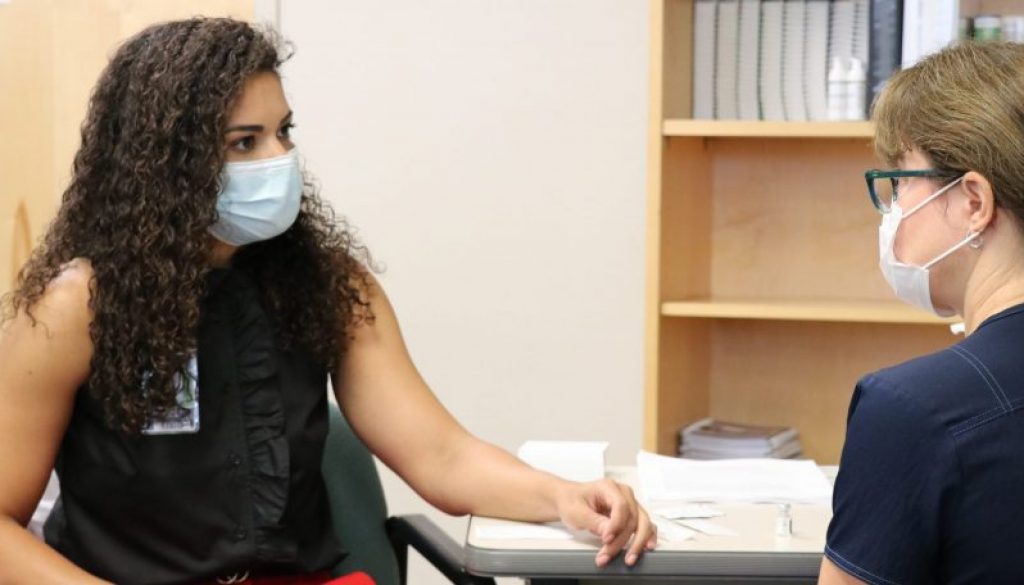
7 These steps are important to the production of antibodies, but they can also lead to common side effects such as raised body temperature (fever), headache, muscle soreness and shivering (chills). To make antibodies, the immune system goes through a number of complex steps, including making proteins called chemokines and cytokines that can influence how cells in the body behave. 6 This is why people are encouraged to continue practicing COVID-19-safe hygiene (hand washing, physical distancing, mask wearing, etc) after they receive their COVID-19 vaccine. On average, it can take up to 14 days after a vaccination for best possible protection to develop. 6 Once a person has the antibodies, their immune system is better able to protect them if they are exposed to that particular virus or bacteria in the future. Vaccines mimic infection and stimulate a person’s immune system to produce antibodies against a virus or bacteria, without the person experiencing the actual infection. 5The vaccines, and number of doses you receive will depend on factors such as how old you are, if you identify as an Aboriginal and/or Torres Strait Islander person, and if your immune system is not working correctly.

4Ĭ This vaccine is not included in the national rollout.ĪTAGI recommends different vaccines and doses for different ages and population groups. Spikevax Bivalent Original/Omicron (Moderna) cĬOVID-19 Vaccine Janssen (Janseen-Cilag) cĪ Information correct as at 2 September 2022.ī Although approved for people aged 18 years and over, this vaccine is not preferred for those aged under 60 years. Current recommendation is to use if no other vaccine is suitable SARS-CoV-2 rS (NVX-CoV2373) COVID-19 vaccineġ8 years and over. You can read the consumer medicine information (CMI) leaflet for each vaccine by clicking on the name. 6,7 No recommendations about the use of the vaccine have been released.ĬOVID-19 vaccines with provisional approval by TGA for use in Australia. The COVID-19 Vaccine Janssen (available as Johnson & Johnson COVID-19 vaccine overseas) and Spikevax Bivalent Original/Omicron (Moderna) have also received provisional approval for use in Australia, but are not part of the national rollout. Please note that the age and dose intervals described in the provisional approval documents for these vaccines may be different to the ATAGI recommendations. The age and dose interval recommendations have been made by ATAGI according to current national and overseas evidence. Doses are given 8 weeks apart unless advised otherwise by a medical professional. Vaccine is recommended for people aged 18 years and over, given in two doses 3–8 weeks apart.Ĭhildren aged 5–11 years old receive a smaller dose of the Comirnaty (Pfizer) vaccine (one-third the adult dose) compared with older children and adults. Both types of vaccine are given in two doses, with 3–8 weeks between doses of the Pfizer vaccine, 4–8 weeks between doses of the Moderna vaccine, and at least 12 weeks* between doses of the AstraZeneca vaccine. The mRNA vaccine from Pfizer is recommended for people aged 5 years and over, while the Moderna vaccine is recommended for people 6 months and over.

The AstraZeneca vaccine is recommended for people aged 60 years and over*, 4 or aged 18 to 59 in outbreak areas if they do not have immediate access to Comirnaty (Pfizer) or Spikevax (Moderna).
Are stomach issues a side effect of covid vaccine free#
1 COVID-19 vaccines delivered as part of the rollout are free for everyone living in Australia and no consultation fee is charged. Four vaccines have provisional approval for use in Australia’s COVID-19 vaccination rollout program: Comirnaty (Pfizer/BioNTech), Spikevax (Moderna), Vaxzevria (previously COVID-19 Vaccine AstraZeneca) and Nuvaxovid (Novavax).


 0 kommentar(er)
0 kommentar(er)
